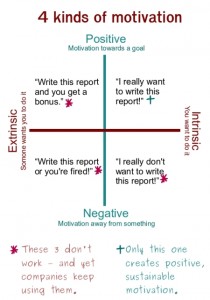My teacher Stephanie and I were discussing after one of my lessons, “How do you motivate student to practice their instrument?” I first thought back on my history of taking lessons from various teachers and struggles I’ve had with motivation for practice. You’ve got your parents paying for your lessons, and they’re pressuring you to practice, “or we’ll stop taking piano lessons”. A few of my past teachers might have given me the guilt trip on a few occasions. I’ve also had experience with practice logs for band where we had to mark the time we spent each day on practice—that one was my least favorite, ugh.
Well the question stuck with me. I wanted to dig down deep into the human psyche, get to the bottom of what motivates us as humans, and then build from that an outline that might be useful for music teachers, parents, and students alike in motivation for practice. (I’m no psychiatrist, so I’m making assumptions with very limited study and research, i.e. the internet. Ha!)
The basics of motivation.
So, off I go to the Google, and type in “What motivates human behavior?”
Right away, I discovered that human motivation can be broken down into two basic categories: extrinsic and intrinsic. Check out this great graphic at left, it sums it up very simply. (click to see the full size) Here, we can already see that positive intrinsic motivation is ideal.
Extrinsic Motivation.
 Let’s break these down further. Extrinsic motivation comes from outside influences, and is kind of seen as the “bad guy”. There’s a lot of articles out there that question its effectiveness. Here are some examples of extrinsic motivation:
Let’s break these down further. Extrinsic motivation comes from outside influences, and is kind of seen as the “bad guy”. There’s a lot of articles out there that question its effectiveness. Here are some examples of extrinsic motivation:
- Positive: trophies, bonuses, grades, cheering, money, fame, recognition, awards, special privileges
- Negative: punishment, threats, bribery
Some say that the downside of extrinsic motivation is that, once the reward is removed—you can kiss that motivation goodbye too. Not only that, but extrinsic motivation can drive people to do things even when they’re not intrinsically inclined to it.
For instance, Cats aren’t intrinsically motivated to take baths, but here’s a cat that was “bribed” into it with a laser pointer.
Extrinsic motivation is not all bad though. Sometimes it’s extremely effective at motivating us to keep moving even when the going gets tough. The roar of the crowd at a sporting event might be just the kick in the pants an athlete needs to push ahead to first place and win the race. In addition, “It paves the way for the individual to set goals. By setting their eyes on the prize, the individual will consort to playing by the rules and even develop a huge amount of persistence towards getting that reward.” I’ve heard of parents giving cash awards to their children when they get good grades in school, and that tends to get very good results. Along the way, the child would learn how to get those good grades: study habits, reading skills, note taking, etc.
At the end of the day though, extrinsic motivation is a short-term solution. It might help a student get over the “I can’t do this” hump—but once a student is proficient at it, they’ll get bored. So what is the answer?
Intrinsic motivation
 Desire to learn an instrument has to come from within the student. There’s a theory by Professor Steven Reiss that 16 basic desires guide nearly all human behavior. (I’ll just list the ones that I’d like to deal with in relation to learning an instrument, but you can look at this wiki link for the others if you’re curious.)
Desire to learn an instrument has to come from within the student. There’s a theory by Professor Steven Reiss that 16 basic desires guide nearly all human behavior. (I’ll just list the ones that I’d like to deal with in relation to learning an instrument, but you can look at this wiki link for the others if you’re curious.)
- Acceptance, the need for approval
- Curiosity, the need to learn
- Honor, the need to be loyal to the traditional values of one’s clan/ethnic group
- Independence, the need for individuality
- Order, the need for organized, stable, predictable environments
- Power, the need for influence of will
- Saving, the need to collect
- Social contact, the need for friends (peer relationships)
- Social status, the need for social standing/importance
After learning all of this, my final question was… “Is there a way a teacher can encourage intrinsic motivation?” Well, that’s kind of contradictory, isn’t it? External pressure to increase intrinsic motivation sounds a little crazy. I believe that this paradox is the basic reason why teachers can’t do much to “make” their student practice. Well, I came up with some tips that I thought could maybe leverage the intrinsic motivations within a student. (As well as a few items I consider to be DON’TS)
Those tips are posted in the second half of this post.
Emily is a student and friend of Stephanie’s, and helps with occasional harping/blogging enthusiasm.
Stephanie Claussen teaches harp lessons out of her home in St. Paul, Minnesota. She strives to ingrain in each student not only correct hand position, rhythm and a sense of musicality, but also a love for making music.

